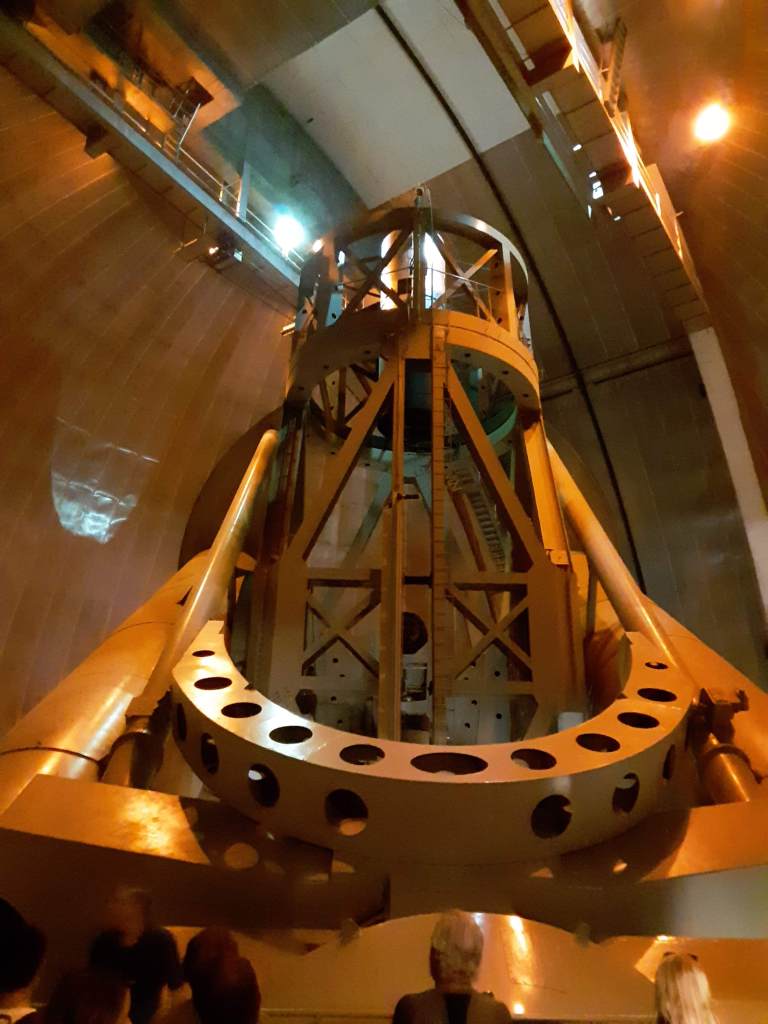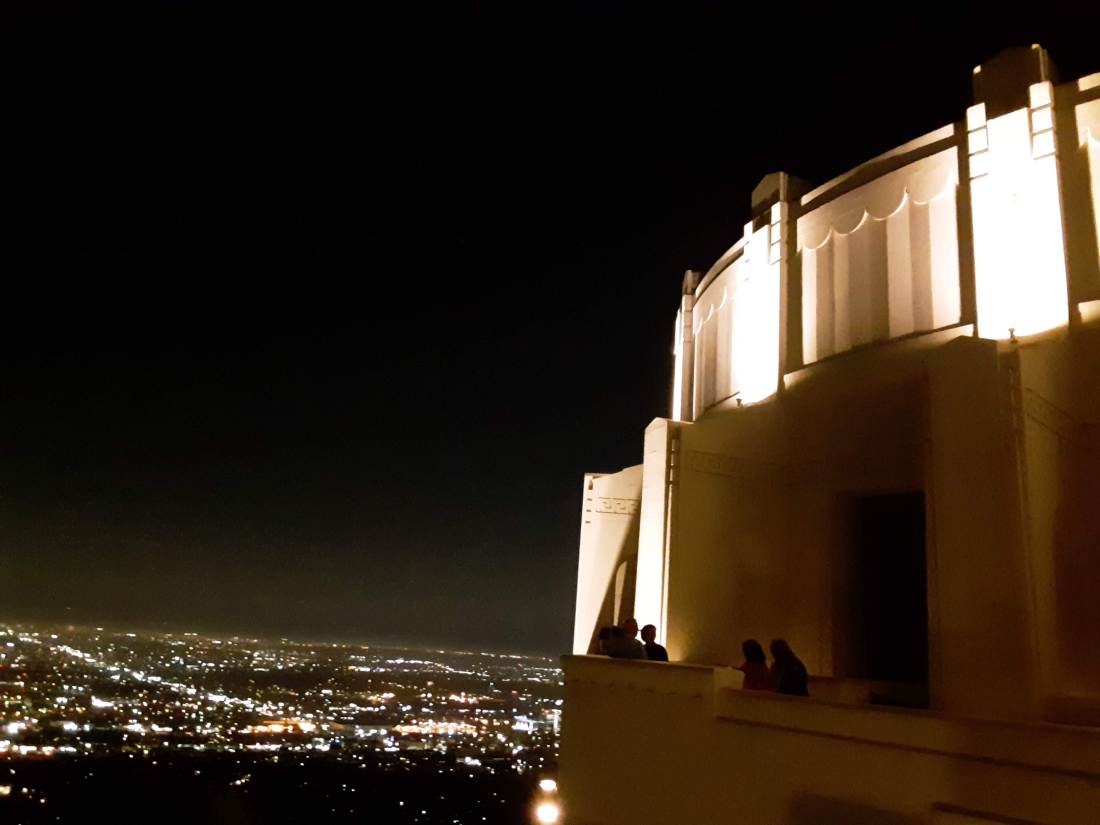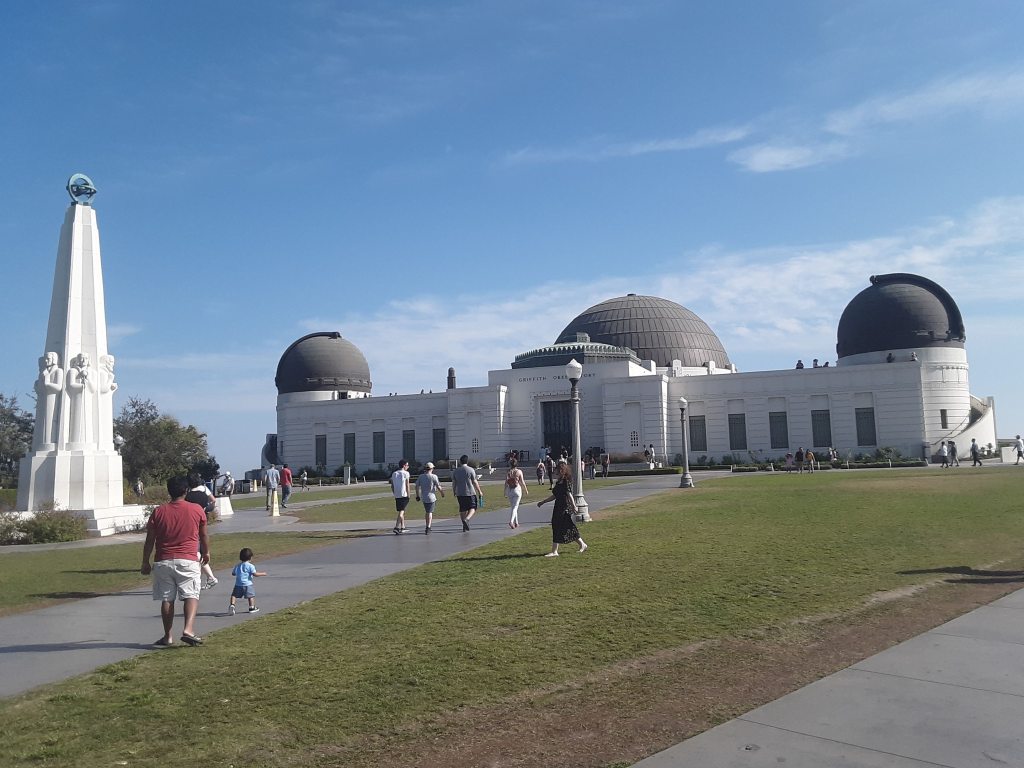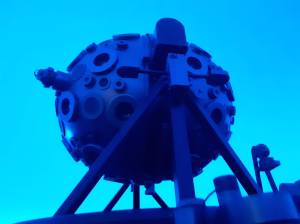My time in California was very full! I was in Los Angeles for a week and saw the California Science Center, the Griffith Observatory, the Palomar Observatory (about which you are about to read), the Mount Wilson Observatory, and the Planetary Society home office (the latter two about which you will read someday soon). Other than seeing the Hollywood sign from Griffith Observatory, I didn’t really do much in the way of typical tourist sightseeing. Of course, I was a pilgrim and not a tourist, so I’m not really upset about that. I do hope someday to return to LA and engage more in its culture, but for now, let’s get on with Mount Palomar, which I visited on September 1, 2018.
Palomar: The Short Form
The following is what I managed to record in my journal, which, if you are a regular reader you know, is woefully incomplete but helpful as far as it goes.
Two and 1/2 hour drive SE through a couple reservations to Palomar Mtn. It’s still an active research facility so they kick everyone out at 4pm. Conditions are good enough they observe [on] over 300 nights a year. There is a nice little visitor center with lots of posters about the history and science. A few interactive displays. Nice gift shop with lots of swag.
The dome of the mighty 200″ Hale is beautiful Art Deco style, designed as a “cathedral of science,” and you get that in its scale, design, beauty, and acoustics. The mount and scope are epic in proportion. Dwarfed by the next generation coming online but really just massive. It’s like a battleship of astronomy. It has been upgraded with adaptive optics, so it can produce better resolution images that the puny Hubble. A great experience to be there.
– written 9/5/2018 at Albuquerque, NM
That’s it. I’ll try to fill in some gaps here next, and you can also see my pictures with commentary >HERE<.
Palomar: The Long Form
I had been to Griffith on Friday evening, and Saturday was my day for Palomar, which was only offering tours on the weekends. It was a two and a half hour drive southeast from LA to Mount Palomar, and since I planned to attend worship somewhere on Sunday, it seemed like a good idea to make the long drive on Saturday and go to the more local Mt. Wilson on Sunday. The drive down was pleasant enough on a beautiful, warm fall day. It was mostly freeway driving (about 100 miles / 160 km) until it wasn’t, getting off I-15 about 15 miles (24 km) north of Escondido, then heading east on highway 76. This was also a pleasant road which included going through several small towns and at least two Indian reservations, the Pala and La Jolla. Lastly there was the standard narrow, winding road up the mountain to the observatory. I remember a couple of these (Kitt Peak, especially) to be white-knucklers, but I don’t remember that about Palomar, so either it was an easier road or I was getting used to the hairpin switchbacks.

Arriving
When you arrive at the top, there is a midsize parking lot with a couple picnic tables around as I recall. Simple signs indicate when and where to go and warn that the gate is closed at 4pm. The grounds are well kept but not manicured, looking fairly natural in some areas. If you stick to the path (as directed by the signs) you soon come to the visitors center, which is a low, small, simple building. Inside is a guestbook, restrooms, the gift shop, and the display hall. You buy tour tickets at the gift shop, as seems to be the case at most of these facilities. The displays in the hall include a model of the 200″ telescope and its dome, an actual 18″ telescope used for several decades onsite, and mostly illuminated posters full of words on the walls. Having taken the time to read a lot of the words, there is a lot to be learned there. But you have to be willing to take the time to read it all. My guess is a lot of people and kids especially miss most of that information. Kind of a shame, really. I feel like they could update some of the displays to be a little more interactive. The posters have cool color illustrations that are eye catching, so that’s good. Just … there are so many words!

I arrived at about 11:00 a.m., and if I remember correctly, my tour was at 1:00 p.m. There was no cafeteria or food service, and I don’t remember exactly what I did for food. It runs in my mind that I packed my lunch and ate it in the car between reading all the words and going for the tour. Let’s go with that.
A Cathedral of Science
The tour started at the back of the dome for the 200″ Hale telescope (a.k.a. “the Big Eye”), so I wandered over and got there early. (This “early” as you call it is something that happened to me quite often on the Grand Tour and rarely happens to me in real life. Now that I’m admitting that to you, I suppose I have to consider why that is so. Anyway…) The Palomar dome looks like it could be a monument on the Mall in Washington, DC, a beautiful, smooth, bright white dome with art deco ornamentation on the shutters. Against a blue sky with the sun on it, it is absolutely stunning. It is so iconic that many pop culture references to observatories, whether in movies, cartoons, or comics, are based on Palomar.
We met at the back door, essentially. There were maybe 20 people in the group and a couple docents. The tour started outside there with an overview of some of the history of the site. The 200″ telescope project was a direct result of the 100″ telescope at Mt. Wilson – both from the work being done with it and the fact the its mirror was remarkably poor in its fabrication. But more on that when we get to Mt. Wilson! The 200″ was the brainchild of George Ellery Hale, who conceived it and arranged financing for it in the late 1920s. It was designed in the 1930s during the Great Depression, working to overcome a variety of new technological issues, including how to cast a mirror that big and then how to support its weight. The outbreak of World War II put work on the project on hold so that it wasn’t commissioned until 1948, twenty years after its conception and ten years after Hale’s death. The telescope was then named for Hale, and so he achieved the creation of the world’s largest telescope four times in a row: the Yerkes 40″ refractor, the Mt. Wilson 60″ reflector, the Mt. Wilson 100″ reflector, and the Palomar 200″ reflector, all of which were of course on my list for the Grand Tour.
We entered the observatory building from that back entrance into the downstairs maintenance area. Honestly, after all this time, I don’t remember much about this part of the tour, except that recurring sense that real science smells like oil and steel. There was interesting information delivered to us, but it beats me what it was. Well, there was the massive beams supporting the structure of the dome and the telescope mount on the floor above us. The colossal loads beneath which we stood have been ably held by these Atlas-like foundations for over 80 years so far. So we got that sense of scale before even seeing the Big Eye.
We made our way upstairs to the observing floor. This is very cool, and not everyone gets to do this. If you don’t take the guided tour and come during the week, you can only get to the visitors gallery, which is a room on the side with a glass wall. That would be lame. Meanwhile, being out on the floor didn’t mean we could touch the scope or anything, but we were out under that magnificent dome! They say the building was designed as a “cathedral of science,” and it certainly feels that way! First, it is a vast, soaring, majestic space like a cathedral. Second, on the inside the dome appears to be made of stainless steel panels, and the light under the dome is reflected in rich, warm tones that give it a sense of artistry and beauty, qualities notably lacking in most other similar structures. Third, the acoustics under the dome are very much like a cathedral. It doesn’t take much to be heard from some distance, and all that is said hangs in the air in the reverberations. Last, they have done a lot of holy science in there, as mere mortals stretch out to reach and understand heaven.

All Hale the Big Eye!
The telescope itself is simply colossal. I mean, it’s not as big as the Large Binocular Telescope, but that’s really two anyway, so it isn’t a fair comparison. But this has the same feel of just being huge. The mount, a polar-aligned fork mount, is like a big suspension bridge or something on a battleship. The optical tube, an open steel cage, is like a water tower. The mirror is obviously 200″ or five meters or 16 feet 8 inches in diameter. That’s two and 3/4 times my height. Yes, I know I saw several mirrors almost twice that size in Arizona (SML / LBT), and yes, they are phenomenally large. But standing next to the mirror cell for this venerable, world changing and still world class telescope, I was impressed by its size. Sue me! The mirror cell is, I’m pretty sure, bigger than my car… yes, I just checked. Definitely bigger than my car. I think it is actually possible to ride in the cage under the mirror cell. Interestingly, the cage at the other end of the tube, the top, where the secondary mirror sits, originally was designed so someone could sit there and, by observation and manipulation, guide the telescope to stay on its target. That was actually someone’s job, to ride at the top and steer the telescope all night! This got to be pretty cold, as you might imagine, especially if you’ve ever spent a non-summer night out under the stars. Eventually they got their hands on some war surplus electrically heated flight suits (they have one on display), and thus the poor grad students or whomever could avoid frosting over.
I would love to have a chance to see through the Big Eye. Of course, it is still used for real scientific work, so letting tourists use it isn’t really going to happen. Besides, it has been refitted, as virtually all modern scientific instruments are, to be strictly photographic. As far as I know there isn’t a visual eyepiece to look through even if you got the chance. But what a view it would offer if you could see through it! As mentioned above, it also has been fitted with adaptive optics, which means a software system analyzes turbulence in the atmosphere and mechanically deforms the telescope mirrors (generally the secondary mirror) to compensate for that turbulence, effectively removing the effects of the atmosphere from the image. Along with that, as I consider the size of the instrument, I’m aware that it is 25 times larger than my backyard telescope. That means for every one photon hitting my mirror, the Big Eye gets 625. What a remarkable, even transcendent experience it must have been to look through that on a steady night! I wonder if those astronomers in the early days ever got bored or jaded or blasé about what they could see. I suppose they did, but I hope not.
The tour ended with some Q&A, then a walk down a long flight of stairs to the front door of the dome, with a bust of Mr. Hale sitting just inside the door. Outside it was a beautiful, warm fall day, just as it had been when we started, but it seemed like we had traveled through time and space. I mean, technically we did travel through a couple hundred meters and a couple hours, but it felt like cosmic distances and long eras. It was like coming out of a ride at DisneyWorld. It was like coming out of a blockbuster movie. It was like coming out of a really good worship service. That’s the proper effect of a pilgrimage site, or the experience created by interacting with true creativity, to break us out of our ordinary timeline and allow us to imagine a broader universe.
Having had such a broadening experience, I bought a bunch of swag at the gift shop and made my way back to my apartment.





